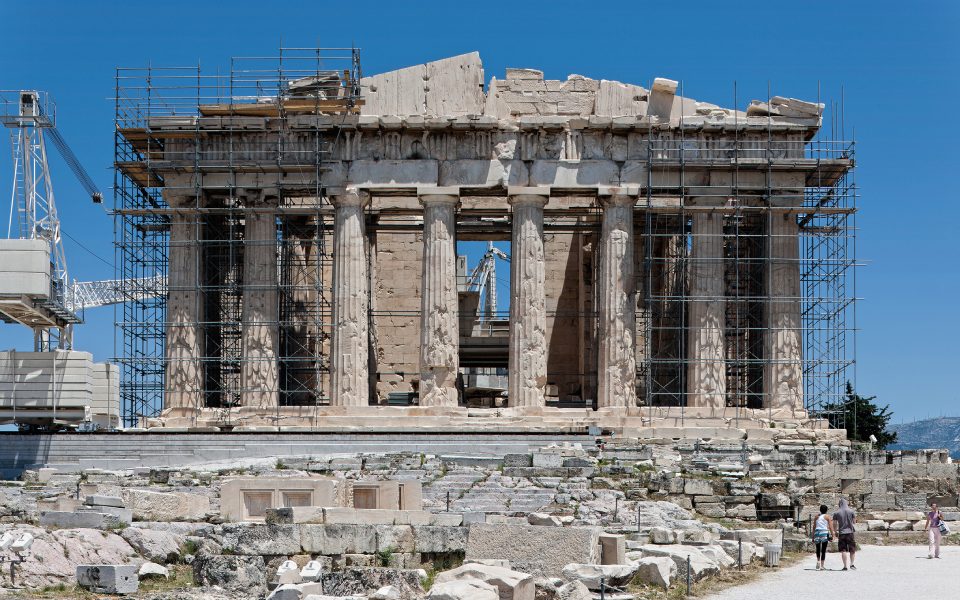One of the strangest stories to come out of the restoration works on the Athens Acropolis is the discovery of ancient artifacts – dating to the time of Pericles – found lodged inside the marble “fabric” of the Parthenon.
These mysterious objects, long hidden high up within the building’s superstructure, shed light on the Parthenon builders’ ordinary daily activities, and the special spiritual or culturally symbolic significance that 5th-century BC Athenians may have attached to certain parts of their patron goddess Athena’s revered temple.
Humble Offerings
Imagine the surprise felt by the modern stonemasons, architects and engineers when they stumbled on ancient objects left behind by their Classical-era counterparts during the years of the Parthenon’s original construction (447-438 BC).
The Acropolis had already long been a sacred place where well-to-do Athenians erected prominent, finely-crafted dedicatory offerings. In the mid-5th century BC, however, the summit of the “Sacred Rock” began swarming also with workers, employed for Pericles’ ambitious renovation program. It now appears that these workers, too, wished to leave a trace of their own faith, gratitude and hopes for continued divine protection.
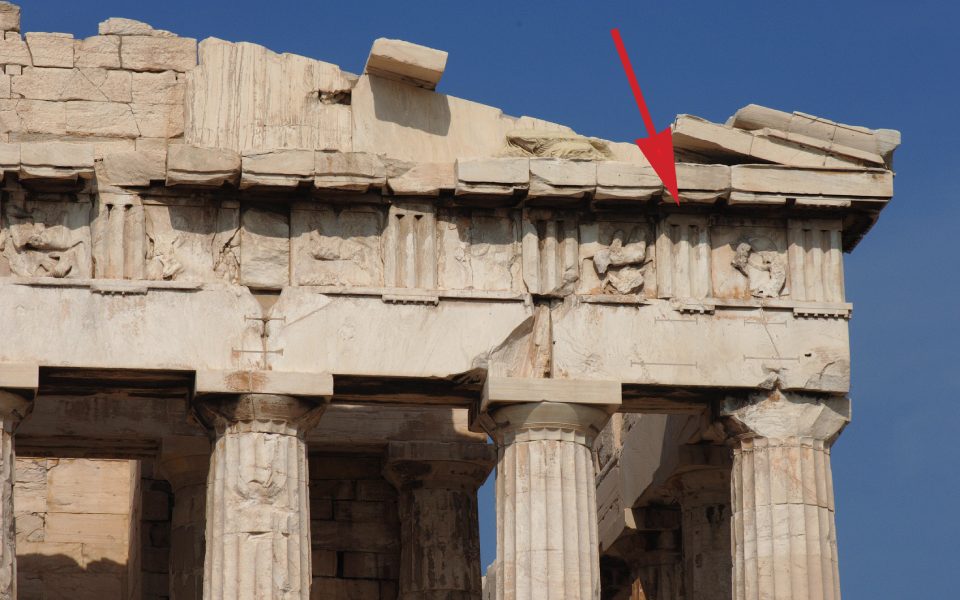
© YSMA Archives
Secrets within the Walls
The story of the Parthenon’s hidden artifacts first came to light in Athens some four years ago, but was recently presented before the annual conference of the Archaeological Institute of America in Washington DC, by Acropolis archaeologist Eleni Karakitsou.
In March 2012, as the Parthenon’s southwest corner became a focus of attention for the Acropolis Monuments Restoration Service (YSMA), a miniature, encapsulated archaeological site, or “feature,” was unexpectedly encountered when workers began disassembling the temple’s entablature. Inside a narrow cavity, between the 14th triglyph (from the north) and the block behind it, an undisturbed deposit of loose soil and marble chips was revealed, which contained a shallow bronze bowl, called a “phiale.” In it was part of an animal leg bone with a bronze tube fitted inside – probably a musical pipe or “aulos.”
These objects lay near the bottom of the cavity just below the surface of chips and dirt that appear to have accumulated inside the void (10-20 cm thick) from the masons’ activity and probably as a result of exposure to the elements. Visible in the earth around the artifacts were dark, distinctive traces of burning, apparently from a localized, perhaps ceremonial fire.
The bronze bowl has been identified by Karakitsou as a mesomphalic phiale (~22 cm diameter), possibly of Greek or Eastern type, common throughout the mid-6th c. BC, with a central “omphalos” or projection inside. Its interior and exterior decoration consists of repoussé (hammered) wreaths of lanceolate leaves around the central omphalos, while its sides are similarly adorned with lanceolate leaves and a crosshatched band. The rim carries a barely legible votive inscription, of Archaic date, directed “most probably to the goddess Athena.”
Karakitsou notes such bronze offerings on the Acropolis were retained in the sanctuary’s permanent treasury of votive dedications and were hence considered to have “divine energy”. They were occasionally brought out for religious rituals, with each new reuse making them “even more precious and sacred.”
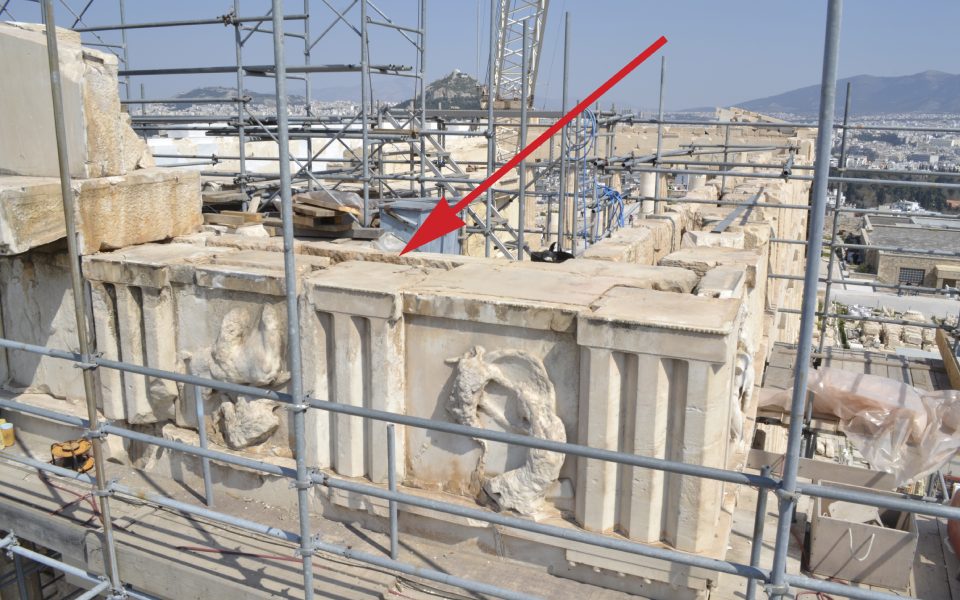
© YSMA Archives
A Tale of Three Pots
The 2012 discovery was not the first bronze vessel to be found inside the Parthenon’s walls. In 1986, a shallow, bronze phiale-like bowl was recovered from a gap between the architraves on the temple’s east end. Its dented condition and interior traces of red-earth paint (miltos), however, indicated it was a worker’s paint pot that had accidentally fallen down between two members.
Then, in 1994, another bronze vessel was discovered near the southeastern corner of the Parthenon’s west porch, also fallen into a gap inside the wall. Although resembling a phiale, this shallow bowl turned out to be part of an old kylix (chalice), dated 500-480 BC, according to archaeologist Christina Vlassopoulou, of “Eastern Greek-Achaemenid” (Persian-influenced) style. It was also a cherished votive offering to Athena (with an inscription naming the dedicant as “Nauarchos”), which had lost its stemmed base and handles. It too, however, had traces of miltos inside, as well as spilled around its findspot, and was clearly being reused as a worker’s paint pot when it slipped down and was lost in the wall.
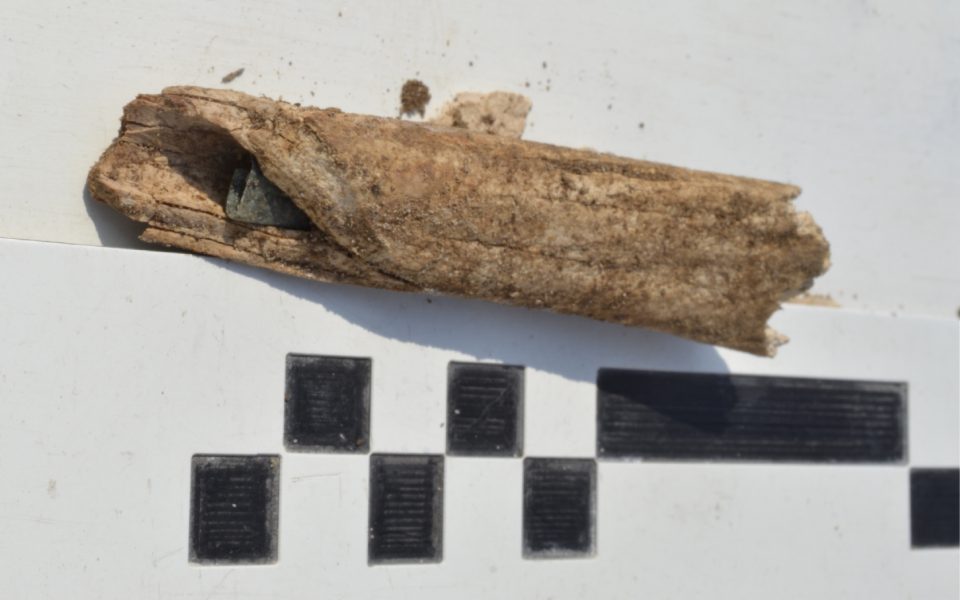
© YSMA Archives
Libations
The unusual circumstances of the 2012 phiale, with the burning and aulos, indicates this latest bronze vessel was involved in some sort of religious ceremony, probably a libation offering accompanied by a small ritual fire. Phiales were often used for libations, when wine, oil, honey, milk or even sacred water were poured out as a thank-offering or votive to the gods.
The Caryatids of the Erechtheion were originally holding phiales in their right hands, perhaps as they prepared to offer libations to Kekrops, the mythical king of Athens, believed to be entombed just beneath their porch. Libations were common at symposia, weddings (sometimes as gifts), athletes’ victory celebrations, momentous departures and funeral banquets. During the ritual, a priest or priestess would offer gratitude or a votive appeal for divine favor while pouring out the libation, to the musical accompaniment of a “spondaulis” or flute player.
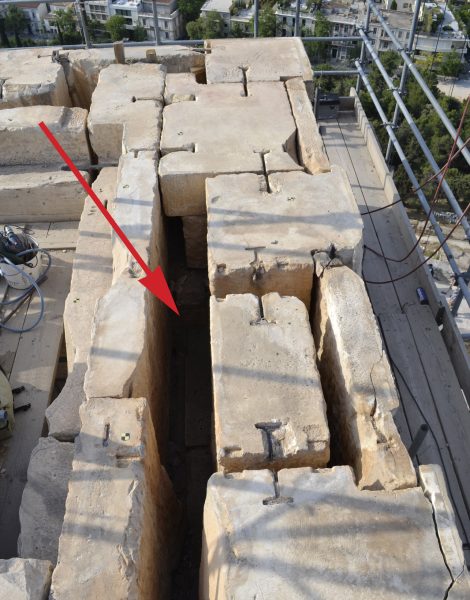
© YSMA Archives
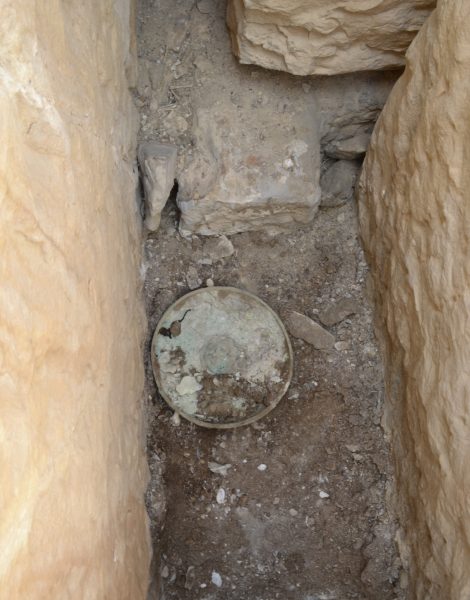
© YSMA Archives
An Appeal to the Heavens
Unlike the accidentally lost 1986 and 1994 paint pots, the 2012 phiale had been intentionally positioned in its final resting place behind the triglyph. But for what reason? And why was it left at that particular spot in the Parthenon’s still-incomplete structure?
Karakitsou suggests it was “a lasting gift presented to Athena,” as well as “an official expression of piety and a request for protection, on behalf of the entire city.” Nevertheless, the phiale’s singular position, inside the walls of the half-constructed Parthenon, high up in a spot accessible only by scaling the wooden scaffolding that still enshrouded the temple, makes one wonder if the libation was less of a formal municipal ceremony by city officials than an ad hoc offering made by the temple’s workers and perhaps its architects, Iktinos and Kallikrates.
Karakitsou’s conclusions on this enigmatic ceremony are inspiring and thought-provoking. The libation was made at a critical juncture in the Parthenon’s construction when the building had nearly been finished, but still awaited its roof. The builders “desired to thank the goddess for her help in completing the temple up to that point, and to ask her for further aid in now successfully completing the project.” Even more intriguingly, Athena “became a partner and protector during the act of construction. The builders sought to strengthen the temple’s corner under [her] watchful eye because solid and secure corners contributed to the structural strength and durability of the temple.”
Furthermore, Karakitsou notes, the libation performed in the entablature had no connection with the building’s initial inauguration ritual – its “engainia” – which was held on the building site prior to the launch of the temple’s construction. In that case, a sacrificial animal and various votive objects were laid on a fire kindled in a shallow pit in the ground, which were later obscured by the building’s foundations and floor.
An engainia was an appeal to the evil-averting powers of chthonic deities deep in the earth, while the libation high up on the Parthenon was instead a thank-offering and votive appeal “to the divine, life-giving forces from above, in the heavens.”
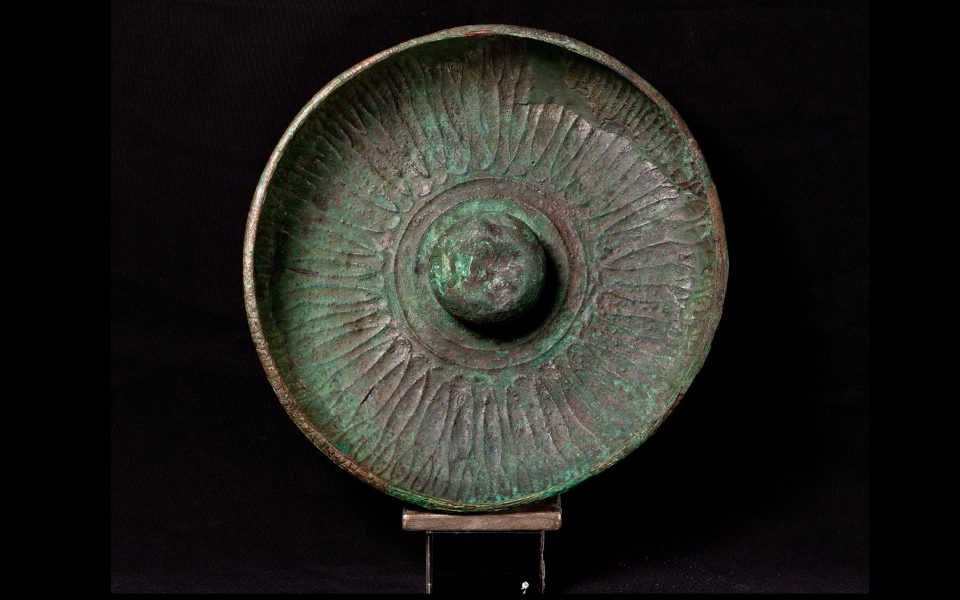
© YSMA Archives
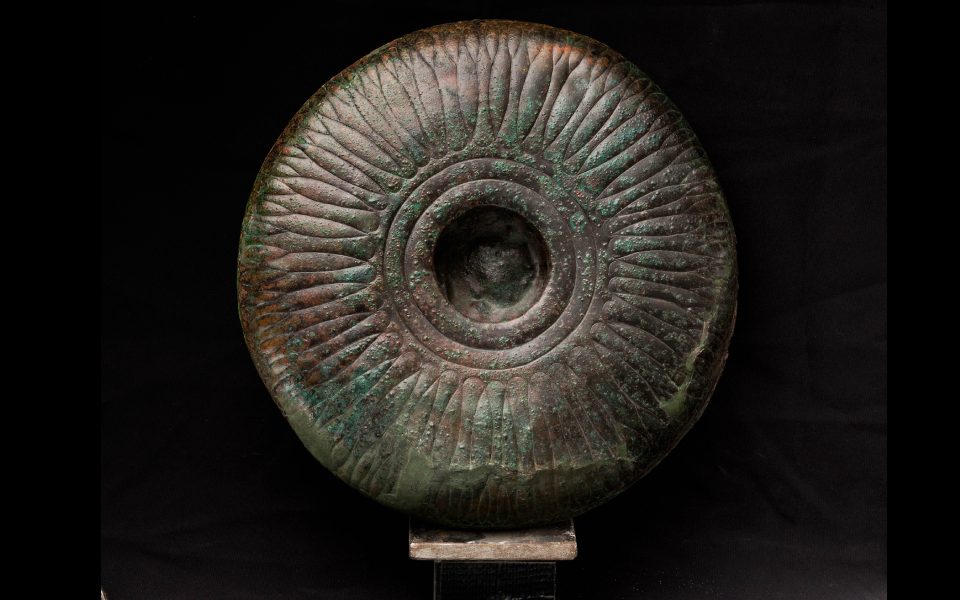
© YSMA Archives
A Nexus of Artistic, Divine and Cultural Power
The southwest corner of the Parthenon, it seems, held a special significance. It was here that the temple’s Ionic frieze began, flowing to the east and north until it met again over the building’s main, east entrance. On the temple’s exterior, the sculpted metopes told the allegorical myths of the Centauromachy (south) and the Amazonomachy (west), which have long been understood to represent the Greeks’ restoration of order from chaos; the importance of Theseus who led the Athenian victory in Attica over the invading Amazons; and the supremacy of Athens over other Greek city-states, due to its leading role in defeating the Persians in 480 BC. Also on the west end of the Parthenon were the pedimental statues that depicted Athena’s contest against Poseidon.
Thus, the southwest corner, the only corner of the temple that points directly to the sea, served as a particular focal point of power – drawn from its association with nearby Athena, Poseidon (protector of Athenian sea power) and Theseus (co-fathered by Poseidon and mortal Aegeus), in combination with its direct visual connection with the Aegean Sea – Athens’ far-reaching domain and the setting for the city’s recent humiliation of the Persian navy.
The southwest corner “was a place where numerous visual messages of great religious and cultural significance to Athenians came together,” Karakitsou proposes. Whether the libation in the entablature was related to this concentration of symbols and beliefs remains an intriguing mystery. It may have been not only a thank-offering to Athena, a request for further success in the building’s construction and a practical appeal for the corner’s static strength, but also a wish for protection of all Athenians, expressed at a spot from which one could look out over the sea and recall Athens’ naval and regional supremacy.
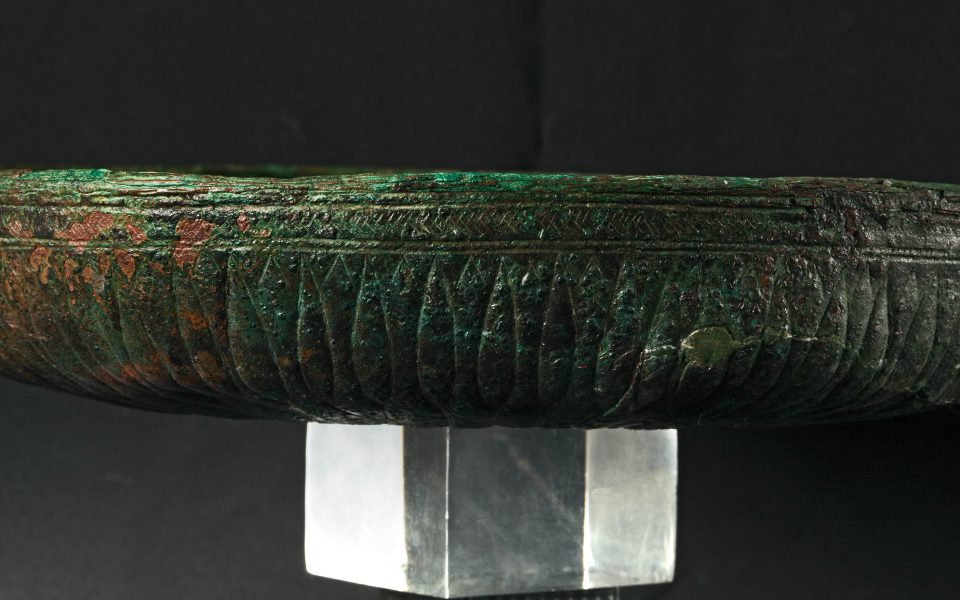
© YSMA Archives
Useful, Meaningful Antiques
Adding another possible layer of meaning to this story of hidden artifacts are the individual histories of the vessels themselves. The fact that the kylix and phiale were both “antiques” shows that old dedications were kept in the Acropolis sanctuary. Demonstrating the Acropolis builders’ sense of practicality, however, in both utilitarian and religious terms, these two votive offerings dedicated to Athena were reused for practical or ritualistic purposes.
During the Parthenon’s construction, the old kylix, a stored sacred offering apparently broken at some point, was reused as a paint pot. Similarly, the well preserved Archaic phiale, likely used numerous times before – and probably of western Anatolian, Persian-influenced origin/style, like the kylix, as Vlassopoulou reports – was brought out again for a libation. The treasured object’s own lengthy history would have lent greater sanctity to the religious ceremony conducted on the Parthenon’s entablature.
In a fitting epilogue to the story, after restoration works on the Parthenon’s southwest corner were completed in May 2015, a stainless steel replica of the ancient bronze phiale was laid in its original findspot behind triglyph 14, as a “token of respect” for ancient Athenian customs and “a tangible expression of gratitude” from the modern city of Athens.

